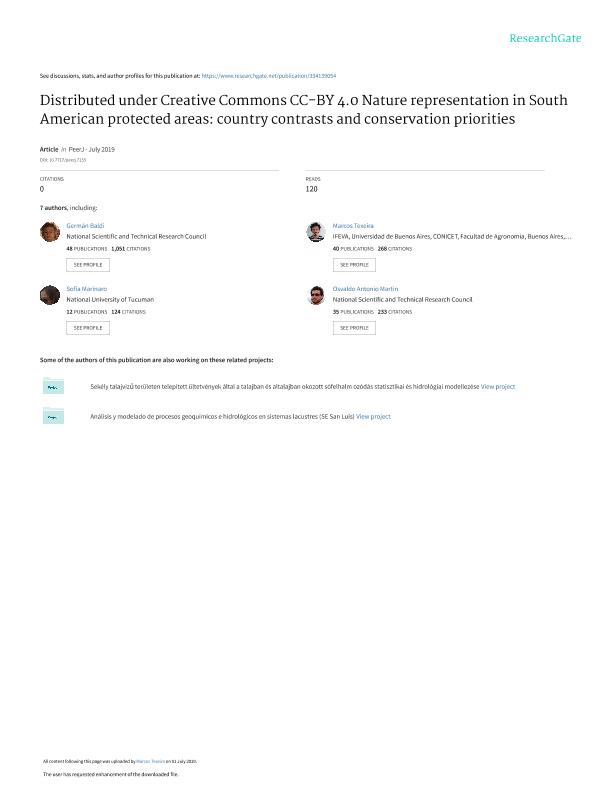Artículo
Nature representation in South American protected areas: country contrasts and conservation priorities
Baldi, Germán ; Schauman, Santiago Augusto
; Schauman, Santiago Augusto ; Texeira González, Marcos Alexis
; Texeira González, Marcos Alexis ; Marinaro Fuentes, María Sofía
; Marinaro Fuentes, María Sofía ; Martín, Osvaldo Antonio
; Martín, Osvaldo Antonio ; Gandini, Patricia Alejandra
; Gandini, Patricia Alejandra ; Jobbágy, Esteban G.
; Jobbágy, Esteban G.
 ; Schauman, Santiago Augusto
; Schauman, Santiago Augusto ; Texeira González, Marcos Alexis
; Texeira González, Marcos Alexis ; Marinaro Fuentes, María Sofía
; Marinaro Fuentes, María Sofía ; Martín, Osvaldo Antonio
; Martín, Osvaldo Antonio ; Gandini, Patricia Alejandra
; Gandini, Patricia Alejandra ; Jobbágy, Esteban G.
; Jobbágy, Esteban G.
Fecha de publicación:
07/2019
Editorial:
PeerJ Inc.
Revista:
PeerJ
e-ISSN:
2167-8359
Idioma:
Inglés
Tipo de recurso:
Artículo publicado
Clasificación temática:
Resumen
Background. South America faces strong environmental pressures as a result of agriculture and infrastructure expansion and also of demographic growth, demanding immediate action to preserve natural assets by establishing protected areas. Currently, 7.1% of the (sub)continent is under strict conservation categories (I to IV, IUCN), but the spatial distribution of these 1:3×106 km2 is poorly understood. We evaluated the representation of nature within the networks of protected areas, map conservation priorities and assess demographic, economic or geopolitical causes of existing protection patterns. Methods. We characterized nature representation by looking at two components: The extent and the equality of protection. The first refers to the fraction of territory under protection, while the second refers to the homogeneity in the distribution along natural conditions of this protected fraction. We characterized natural conditions by either 113 biogeographical units (specifically, ecoregions) or a series of limited and significant climatic, topographic and edaphic traits. We analyzed representation every ten years since 1960 at national and continental levels. In the physical approach, histograms allowed us to map the degree of conservation priorities. Finally, we ranked the importance of different economic or geopolitical variables driving the observed distributions with a random forest technique. Results. Nature representation varied across countries in spite of its priority in conservation agendas. In Brazil, Peru and Argentina there are still natural conditions with no formal protection, while in Bolivia and Venezuela, protected areas incorporate the natural diversity in a more balanced manner. As protected networks have increased their extent, so did their equality across and within countries over time. Our maps revealed as top continental priorities the southern temperate, subhumid and fertile lowland environments, and other country-specific areas. Protection extent was generally driven by a low population density and isolation, while other variables like distance to frontiers, were relevant only locally (e.g., in Argentina). Discussion. Our description of the spatial distribution of protected areas can help societies and governments to improve the allocation of conservation efforts. We identified the main limitations that future conservation efforts will face, as protection was generally driven by the opportunities provided by low population density and isolation. From a methodological perspective, the physical approach reveals new properties of protection and provides tools to explore nature representation at different spatial, temporal and conceptual levels, complementing the traditional ones based on biodiversity or biogeographical attributes.
Archivos asociados
Licencia
Identificadores
Colecciones
Articulos(IER)
Articulos de INSTITUTO DE ECOLOGIA REGIONAL
Articulos de INSTITUTO DE ECOLOGIA REGIONAL
Articulos(IFEVA)
Articulos de INST.D/INV.FISIOLOGICAS Y ECO.VINCULADAS A L/AGRIC
Articulos de INST.D/INV.FISIOLOGICAS Y ECO.VINCULADAS A L/AGRIC
Articulos(IMASL)
Articulos de INST. DE MATEMATICA APLICADA DE SAN LUIS
Articulos de INST. DE MATEMATICA APLICADA DE SAN LUIS
Citación
Baldi, Germán; Schauman, Santiago Augusto; Texeira González, Marcos Alexis; Marinaro Fuentes, María Sofía; Martín, Osvaldo Antonio; et al.; Nature representation in South American protected areas: country contrasts and conservation priorities; PeerJ Inc.; PeerJ; 2019; 7; 7-2019; 1-23
Compartir
Altmétricas



